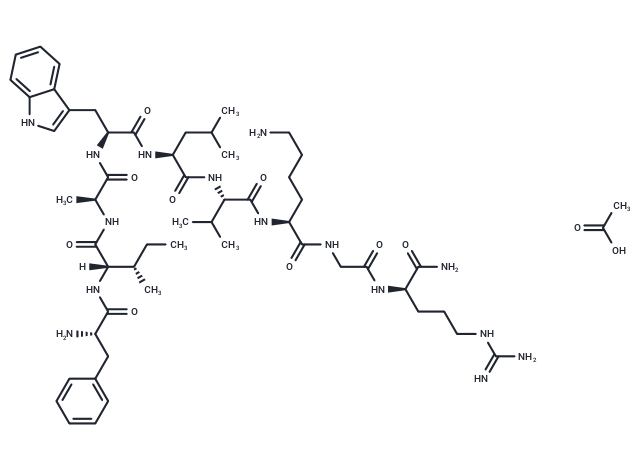Shopping Cart
- Remove All
 Your shopping cart is currently empty
Your shopping cart is currently empty

GLP-1(28-36)amide acetate inhibits mitochondrial permeability transition with antioxidant, anti-diabetic and cardioprotection activities.

| Pack Size | Price | Availability | Quantity |
|---|---|---|---|
| 1 mg | $129 | In Stock | |
| 5 mg | $262 | In Stock | |
| 10 mg | $442 | In Stock | |
| 25 mg | $729 | In Stock | |
| 50 mg | $987 | In Stock | |
| 100 mg | $1,390 | In Stock | |
| 500 mg | $2,780 | In Stock |
| Description | GLP-1(28-36)amide acetate inhibits mitochondrial permeability transition with antioxidant, anti-diabetic and cardioprotection activities. |
| In vitro | The plasma half-life of GLP-1(28-36)amide acetate is longer in human hepatocytes (24 min) than that in mouse hepatocytes (13 min). GLP-1(28-36)amide acetate (100 nM) on hepatocytes modulates mitochondrial oxidative metabolism including gluconeogenesis in mitochondria of hepatocytes[1]. |
| In vivo | In high-fat diet-fed mice, GLP-1(28-36)amide acetate (18.5 nmol/kg) improved hepatic glucose disposal. In diet-induced obese mice, GLP-1(28-36)amide acetate (18.5 nmol/kg BW/day) diminishes the development of hepatic steatosis. In male C57BL6/J mice, administration of GLP-1(28-36)amide acetate for 20 min to, then isolated hearts underwent 30 min of global ischemia and 40 min of reperfusion, the recovery of left ventricular developed pressure is significantly great. In a β-cell injury diabetic mouse model, GLP-1(28-36)amide acetate (18 nmol/kg; i.p.) shows cytoprotective effect on pancreatic β cells by promoting proliferation and increasing mass[1]. |
| Alias | GLP-1(28-36)amide acetate(1225021-13-5 Free base) |
| Molecular Weight | 1148.4 |
| Formula | C56H89N15O11 |
| Smiles | CC(C[C@H](NC([C@@H](NC([C@@H](NC([C@@]([H])(NC([C@@H](N)CC1=CC=CC=C1)=O)[C@H](CC)C)=O)C)=O)CC2=CNC3=CC=CC=C32)=O)C(N[C@@H](C(C)C)C(N[C@@H](CCCCN)C(NCC(N[C@H](CCCNC(N)=N)C(N)=O)=O)=O)=O)=O)C.CC(O)=O |
| Storage | keep away from moisture | Powder: -20°C for 3 years | In solvent: -80°C for 1 year | Shipping with blue ice. | ||||||||||||||||||||
| Solubility Information | DMSO: 11.48 mg/mL (10 mM), Sonication is recommended. | ||||||||||||||||||||
Solution Preparation Table | |||||||||||||||||||||
DMSO
| |||||||||||||||||||||

Copyright © 2015-2025 TargetMol Chemicals Inc. All Rights Reserved.